
|
Sale 80
June Pre Long Beach Sale
| Denarii Collection - Roman Empire |
| |
| |
| Lot |
Photo |
Description |
Realized |
Lot 3099 |
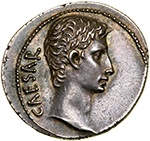 |
Augustus. Silver Denarius (3.78 g), 27 BC-AD 14. Pergamum, 27 BC. CAESAR, bare head of Augustus right. Reverse : AVGVSTVS, bull standing right. RIC 475; BMC 662-3; RSC 28. An absolutely exceptional example, needle sharp and well centered on a perfect flan without the usual flan crack. An exquisite coin with a high relief portrait of fine style and lovely old cabinet toning. Superb Extremely Fine.
Estimated Value $7,000 - 8,000.
Ex Triton XI (8-9 January 2008), 872.
View details and enlarged photos
| Realized
$18,213 |
Lot 3100 |
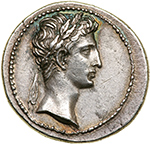 |
Augustus. Silver Denarius (3.87 g), 27 BC-AD 14. Uncertain mint in the East, ca. 27 BC or a little later. Laureate head of Augustus right. Reverse : AVGVSTVS, capricorn right, cornucopiae on its back, holding rudder and globe. RIC 541 (same obv. die); BMC 664 (same obv. die); RSC 23a. A superb portrait struck in high relief. Lightly toned. Extremely Fine.
Although there is a problem of chronology that has not been clearly sorted, Augustus advertised his birth sign as Capricorn. The capricorn was a half terrestrial, half marine being, and played a prominent role in Augustan propaganda, seen on several coin types as well as in other media. Here the capricorn with globe seems to signify Augustus' power over land and sea. The rudder and cornucopiae are terrestrial attributes of the goddess Bona Fortuna, reminding us of Augustus' role in bringing peace and good fortune to the Empire after the devastating civil wars of the 40s and 30s BC.
For an enlightening discussion of Augustus' horoscope and it's use in imperial propaganda, see T. Barton, "Augustus and Capricorn: Astrological Polyvalency and Imperial Rhetoric," JRS 85, 1995, pp. 31-51.
Estimated Value $5,000 - 6,000.
Ex NAC 40 (16 May 2007), 629.
View details and enlarged photos
| Realized
$13,513 |
Lot 3101 |
 |
Augustus. Silver Denarius (3.74 g), 27 BC-AD 14. Emerita, ca. 25-23 BC. P. Carisius, propraetorian legate. IMP CAESAR AVGVSTVS, bare head of Augustus right. Reverse : P CARISIVS LEG PRO PR, facing Celtiberian helmet between dagger and bipennis. RIC 8; BMC 280; RSC 406a. Very Rare. Boldly struck on a wide flan with a finely executed portrait of Augustus. Lustrous surfaces. Nearly Mint State.
The Roman conquest of the Iberian Peninsula took two centuries, from the first landing at Emporion in 218 BC during the Second Punic War until the final conquest of the remaining holdouts in northwestern Spain under Augustus in 19 BC. The reverse of this coin shows the common armament of the Celtiberian warrior, who were extremely skilled in light arms, especially the short sword or dagger and the bipennis, a sort of small double-headed axe.
Estimated Value $8,000 - 9,000.
Ex NAC 59 (4-5 April 2011), 875.
View details and enlarged photos
| Realized
$21,150 |
Lot 3102 |
 |
Augustus. Silver Denarius (3.80 g), 27 BC-AD 14. Colonia Patricia(?), ca. 19 BC. CAESAR AVGVSTVS, bare head of Augustus left. Reverse : IOV TO[N], hexastyle temple of Jupiter containing statue of the god standing left, holding thunderbolt and scepter. RIC 64; BMC p. 64, note; RSC 180. Boldly struck and well centered. Delicate golden iridescent toning. Extremely Fine.
The temple of Jupiter Tonans was vowed by Augustus in 26 BC after his narrow escape from lightening in the Cantabrian campaign and finally dedicated in 22 BC (Suetonius, Vita Augusti 29.91). The temple was originally dedicated to Jupiter Fulgens and was located near the Campus Martius. The cult image it contained which is shown inside the temple on this coin, was by the 4th century Greek sculptor, Leochares, according to Pliny (Hist. Nat. 39.79).
Estimated Value $5,000 - 6,000.
Ex Goldberg 74 (4 June 2013), 3557; Roma IV (30 September 2012), 515.
View details and enlarged photos
| Realized
$8,813 |
Lot 3103 |
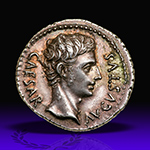 |
Augustus. Silver Denarius (3.87 g), 27 BC-AD 14. Colonia Patricia(?), ca. 19 BC CAESAR AVGVSTVS, bare head of Augustus to right. Reverse : SIGNIS RECEPTIS above and below, S P Q R around, round shield inscribed CL V between legionary standard and aquila. RIC 87a; BMC 422; RSC 265a. Boldly struck with a fine high relief portrait. Perfectly centered on a full size flan with gorgeous cabinet toning with reddish iridescense. Superb Extremely Fine.
The reverse shows the clipeus virtutis, the shield of valor, decreed to Augustus by the Senate in 27 BC. Like the corona civica, it was awarded for saving the life of a fellow citizen.
Estimated Value $12,500 - 15,000.
Ex Nomos 5 (25 October 2011), 230; W. Uibeleisen Collection (Hess-Divo 307, 7 June 2007), 1551; MMAG 81 (18 September 1995), 189.
View details and enlarged photos
| Realized
$23,500 |
Lot 3104 |
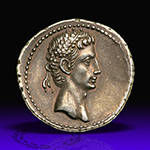 |
Augustus. Silver Denarius (3.72 g), 27 BC-AD 14. Caesaraugusta (?), ca. 19/8 BC. Head of Augustus right, wreathed with oak-leaves. Reverse : CAESAR AVGVSTVS, two laurel branches. RIC 33a; BMC 352; RSC 47. Lovely old cabinet toning with hints of iridescense.A fantastic portrait of great style struck on an exceptionally large flan. Superb Extremely Fine.
When Octavian was awarded the honorary title of Augustus in 27 BC investing him with supreme power, he was also given the right to decorate his door posts with laurel branches, a sign of martial victory, and the corona civica, an oak-wreath symbolizing the saving of a Roman life. In the case of Augustus, the laurel branches signified his victory over Mark Antony and Cleopatra at Actium, and the corona civica was awarded for saving the life of not one citizen but of many thousands when he successfully ending the civil wars. On this coin Augustus is portraying wearing the oak wreath crown - which occurs only occasionally on Roman coins - which by law he was required to do at every public gathering.
Estimated Value $25,000 - 30,000.
Ex Alberto Campana Collection (NAC 64, 17-18 May 2012), 1033; Rauch 82 (23 April 2008), 203.
View details and enlarged photos
| Realized
$36,425 |
Lot 3105 |
 |
Augustus. Silver Denarius (3.79 g), 27 BC-AD 14. Caesaraugusta(?), ca. 18 BC. CAESAR AVGVSTVS, bare head of Augustus right. Reverse : S P Q R / CL V in two lines on round shield. RIC 42a; BMC 334; RSC 294. An incredible example, boldy struck on a wide flan with lovely old cabinet toning. Superb Extremely Fine.
Estimated Value $15,000 - 17,000.
Ex Numismatica Genevensis VII (27-28 November 2013), 327.
View details and enlarged photos
| Realized
$19,975 |
Lot 3106 |
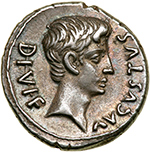 |
Augustus, with Divus Julius Caesar. Silver Denarius (3.9 g), 27 BC-AD 14. Rome, 17 BC. M. Sanquinius, moneyer. AVGVSTVS DIVI F, bare head of Augustus right. Reverse : M SANQVI-NIVS III VIR, laureate, youthful head of deified Julius Caesar right; above, comet with tail. RIC 338; BMC 71; RSC 1. Well struck and perfectly centered. Lovely old cabinet toning with lighter iridescense. Very rare and seldom seen this choice. Extremely Fine.
In 17 BC a comet appeared in the heavens and was taken by the Romans to be the reappearance of the soul of Julius Caesar. With this auspicious appearance, Augustus and Agrippa assumed leadership of the Xvviri sacris faciundis, the college of priests in charge of festivals, and organized celebrations inaugurating a new age. As part of the celebrations, Augustus commissioned the poet Horace to write a secular hymn, the Carmen Saeculare, which was sung by twenty-seven maidens and an equal number of youths on the occasion of the Ludi Saeculares.
Estimated Value $6,000 - 7,000.
Ex The Bru Sale 2 (18 November 2010), 74; Bank Leu 20 (25-26 April 1978), 210.
View details and enlarged photos
| Realized
$11,456 |
Lot 3107 |
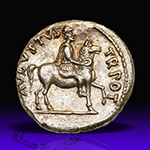 |
Augustus, with Divus Julius Caesar. Silver Denarius (3.7 g), 27 BC-AD 14. Rome, 17 BC. P. Licinius Stolo, moneyer. AVGVSTVS TR POT, emperor, laureate, wearing short tunic and cloak, on horseback right, holding patera. Reverse : P STOLO III VIR, flamen's cap (apex flaminis) between two studded sacred shields (ancilia). RIC 344; BMC 76; RSC 439. Very Rare. Well struck and well centered on a slightly rough flan. Lightly toned. Extremely Fine.
The ancilia was a sacred bronze shield believed to have fallen from heaven during the reign of Numa Pompilius, 715-673 BC, the legendary second king of Rome. His consort, the nymph Egeria, prophesied that wherever the shield was preserved the people would be the dominant people of the world. In order to disguise the identity of the sacred shield, eleven copies were made, and all were carried by the twelve Salian "leaping priests of Mars" during public festivities, especially the Secular Games. The shields were destroyed by fire when the Regia burned in 36 BC, and were reconstructed probably in 17 BC as part of the New Age celebrations that Augustus and Agrippa inaugurated.
Estimated Value $8,000 - 9,000.
Ex Lanz 154 (11 June 2012), 290.
View details and enlarged photos
| Realized
$12,925 |
Lot 3108 |
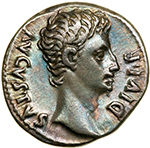 |
Augustus. Silver Denarius (3.76 g), 27 BC-AD 14. Lugdunum, 15-13 BC. AVGVSTVS DIVI F, bare head of Augustus right. Reverse : IMP X in exergue, bull butting right. RIC 167a; Giard 19; BMC 451; RSC 137. A pleasing large portrait of Augustus. Mottled turquoise toning. Choice Very Fine.
Estimated Value $600 - 700.
View details and enlarged photos
| Realized
$1,028 |
Lot 3109 |
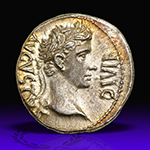 |
Augustus. Silver Denarius (3.83 g), 27 BC-AD 14. Lugdunum, 8 BC. AVGVSTVS DIVI F, laureate head of Augustus right. Reverse : C CAES above, AVGVS F in exergue, Caius Caesar on horseback galloping right, holding reins and sword; behind, legionary eagle between two standards. RIC 199; Giard 69; BMC 500-2; RSC 40. Very Rare. Lustrous surfaces, virtually as struck with hints of golden iridescense. Nearly Mint State.
The reverse shows Gaius Caesar, the eldest son of Agrippa and Julia and the grandson of Augustus, in his first campaigns in Gaul - at the tender age of 12!
Estimated Value $15,000 - 20,000.
Ex Gorny & Mosch 203 (5 March 2012), 316.
View details and enlarged photos
| Realized
$12,338 |
Lot 3110 |
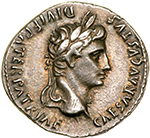 |
Augustus. Silver Denarius (3.77 g), 27 BC-AD 14. Lugdunum, 2 BC-AD 12. CAESAR AVGVSTVS DIVI F PATER PATRIAE, laureate head of Augustus right. Reverse : C L CAESARES AVGVSTI F COS DESIG PRINC IVVENT, Gaius and Lucius Caesars, togate, standing facing, supporting between them on ground honorary shields and spears; above, lituus and simpulum turned inwards. RIC 210; Giard 85; BMC 540; RSC 43c. Well struck and perfectly centered with every letter complete. Excellent compact style. Attractive old cabinet toning with hints of iridescense. Rarely seen this choice!. Superb Extremely Fine.
Augustus formally adopted his two grandsons, Gaius and Lucius, the children of his friend and general M. Agrippa and his only child, his daughter Julia. Both were groomed as heirs, but neither survived him, Lucius dying in Gaul in AD 2 and Gaius in Lycia in AD 4. With their deaths Augustus was forced to look for another suitable candidate to succeed him, and selected his stepson, Tiberius.
Estimated Value $1,500 - 2,000.
Ex Gemini V (6 January 2009), 255.
View details and enlarged photos
| Realized
$3,643 |
Lot 3111 |
 |
Tiberius. Silver Denarius (3.6 g), AD 14-37. 'Tribute Penny'. Lugdunum. TI CAESAR DIVI AVG F AVGVSTVS, laureate head of Tiberius right. Reverse : PONTIF MAXIM, Livia, as Pax, seated right on throne with ornate legs, resting feet on footstool, holding scepter and olive branch. RIC 30; Lyon 150; BMC 48; RSC 16a. Well struck on a nice large flan and perfectly centered. Mottled toning. Extremely Fine.
Estimated Value $1,000 - 1,200.
View details and enlarged photos
| Realized
$1,351 |
Lot 3112 |
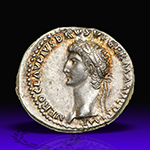 |
Nero Claudius Drusus. Silver Denarius (3.80 g), AD 41-54. Rome, under Claudius, ca. AD 41-45. NERO CLAVDIVS DRVSVS GERMANICVS IMP, laureate head of Nero Claudius Drusus left. Reverse : Triumphal arch surmounted by equestrian statue left between two trophies, DE GERMANIS on architrave. RIC 72; BMC 101; RSC 4. Well struck on a large wide flan with every letter complete. A superb portrait of Nero Claudius Drusus and delicately toned. Very rare and among the finest specimens known. Superb Extremely Fine.
Nero Claudius Drusus was the son of Livia and the senator Tiberius Claudius Nero. Before he was born his parents divorced so that Augustus could marry his mother. Unlike his older brother, the future emperor Tiberius whom Augustus disliked, the emperor doted on his younger stepson.
In 13 BC Drusus was sent to govern Gaul, and while there he repelled an attack by a tribe of Germans who had invaded the province. Most of the following years until his death were spent on campaigns in German territory. First, he crossed the Rhine frontier and penetrated as far as the North Sea, subduing the Frisii. The following years saw him engaged against various confederations of the Chatti, Sicambri and Marcomanni. He died tragically in 9 BC from injuries he sustained when he fell from his horse while on campaign fighting the Marcomanni.
The Arch of Drusus that appears on the reverse of this coin and which commemorated his campaigns in Germania has not survived. Its precise location is not known, but it was on the Appian way.
Estimated Value $25,000 - 30,000.
Ex NAC 62 (6 October 2011), 2018; NAC 29 (11 May 2005), 466; Tkalec (29 February 2000), 234.
View details and enlarged photos
| Realized
$42,300 |
Lot 3113 |
 |
Nero Claudius Drusus. Silver Denarius (3.8 g), AD 41-54. Rome, under Claudius, ca. AD 41-45. NERO CLAVDIVS DRVSVS GERMANICVS IMP, laureate head of Nero Claudius Drusus left. Reverse : DE GE-R-MA-NIS, two oblong shields crossed, over vexillum, four spears and two trumpets. RIC 74; BMC 107; RSC 6. Well struck and perfectly centered on a full size flan, all delicately toned. Very rare and among the finest known. Superb Extremely Fine.
Estimated Value $20,000 - 25,000.
Ex Imagines Imperatorvm (Aureo & Calicó, 8 February 2012), 13.
View details and enlarged photos
| Realized
$31,725 |
Lot 3114 |
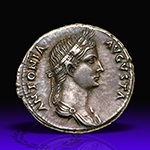 |
Antonia Minor. Silver Denarius (3.85 g), Augusta, AD 37 and 41. Rome, under Claudius, ca. AD 41-45. ANTONIA AVGVSTA, draped bust of Antonia right, hair tied in short queue at back of neck, wreathed with grain ears. Reverse : CONSTANTIAE AVGVSTI, Antonia, as Constantia, standing facing, holding long torch and cornucopiae. RIC 66; BMC 111; RSC 2. An incredible example, boldly struck in high relief, on a full size flan and perfectly centered. Excellent metal and attractive old cabinet toning. Among the finest in existance. Superb Extremely Fine.
Antonia was the younger daughter of Mark Antony and Octavia in 36 BC. In either 18 or 16 BC, she married Nero Claudius Drusus, to whom she bore three children: Germanicus, Livilla and Claudius. Although initially honored with the title of Augusta by her grandson, Caligula, she eventually fell out of favor with him, committing suicide in AD 37 possibly as a result. Her son Claudius reconfirmed the title on her posthumously in AD 41.
RIC notes that the reverse of this type emphasizes Antonia "as the model for Claudius' Constantia and also as the priestess of Divus Augustus, from whom imperial auctoritas ultimately flowed."
Estimated Value $20,000 - 25,000.
Ex Tradart (12 December 1991), 251; Fred Baldwin Collection (Glendining, 20 November 1969), 35.
View details and enlarged photos
| Realized
$64,625 |
Lot 3115 |
 |
Gaius Caligula, with Divus Augustus. Silver Denarius (3.77 g), AD 37-41. Lugdunum, AD 37. C CAESAR AVG GERM P M TR POT COS, bare head of Gaius right. Reverse : Radiate head of Augustus right, between two stars. RIC 2; Giard 157; BMC 4; RSC 11. Boldly struck and well centered with every letter in the legend complete. An incredible example with delicate golden toning. Both portraits are outstanding!. Superb Extremely Fine.
Estimated Value $20,000 - 25,000.
Ex NFA XXX (8 December 1992), 214; Tkalec (26 March 1991), 255.
View details and enlarged photos
| Realized
$31,725 |
Lot 3116 |
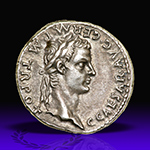 |
Gaius Caligula, with Germanicus. Silver Denarius (3.54 g), AD 37-41. Lugdunum, AD 37/8. C CAESAR AVG GERM P M TR POT, laureate head of Gaius right. Reverse : GERMANICVS CAES P C CAES AVG GERM, bare head of Germanicus right. RIC 18; Giard 172; BMC 19; RSC 2. Well struck and perfectly centered with all letters complete. Delicate antique toning. Extremely Fine.
Germanicus was the son of Nero Claudius Drusus and Antonia, the daughter of Mark Antony, and was born in 15 BC. A scion of the Julio-Claudian dynasty, he also became one of Rome's most successful and beloved generals, having avenged Varus' defeat at the Battle of the Teutoburg Forest, retrieving two of the three lost standards and inflicting heavy defeats against Arminius, the protagonist in Varus campaign. He was not as successful in the field of politics, however, having inadvertently usurped the imperial prerogative on more than one occasion. The most egregious instance was his ordering the recall of the governor of Syria, Gnaeus Calpurnius Piso, for having canceled some of the arrangements for the settlement of Cappadocia and Commagene that Germanicus had ordered. Shortly after this episode, Germanicus fell severely ill and died at Antioch. Suspicion immediately fell on Piso, and it was thought that he had poisoned Germanicus at the instigation of Tiberius who was suspicious of Germanicus' popularity. The truth was never discovered, however, as Piso reportedly took his own life during the course of his trial (Tacitus believed Tiberius may have had him murdered before he could implicate the emperor in Germanicus' death).
Estimated Value $20,000 - 25,000.
Ex The Millennia Collection (Goldberg 46, 26 May 2008), 84; NAC 25 (25 June 2003), 362.
View details and enlarged photos
| Realized
$19,388 |
Lot 3117 |
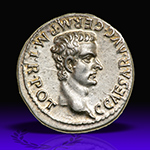 |
Gaius Caligula, with Agrippina I. Silver Denarius (3.69 g), AD 37-41. Lugdunum, AD 37/8. C CAESAR AVG GERM P M TR POT, bare head of Gaius right. Reverse : AGRIPPINA MAT C CAES AVG GERM, draped bust of Agrippina I right, hair tied in queue at back of neck. RIC 8; Giard 169; BMC 8; RSC 4. Two magnificent portraits of the finest style perfectly struck and centered on a full flan. Traces of luster still present and lightly toned. Very rare and among the finest examples known. Superb Extremely Fine.
Perhaps more than any other emperor of Rome Caligula honored his family on his coinage, both living and deceased members. Besides his surviving sisters, amongst those so honored were his great-grandfather Augustus, his grandfather Agrippa, his father Germanicus, and his mother and his two brothers, Agrippina I and Nero and Drusus Caesars, the latter three succumbing in the family's contest for power against Sejanus, Tiberius's notorious Praetorian Prefect.
Early in his reign, Caligula journeyed to the island of Pandataria, where his mother had died while cruelly imprisoned at the order of Tiberius, and recovered her ashes. Agrippina had been a strong critic of Tiberius' principate, questioning him about the mysterious circumstances of her husband's death and also accusing him of having attempted to poison her. Under Sejanus' manipulation, Tiberius' animosity towards her and her family grew increasingly stronger, which eventually lead to them being convicted of plotting against him. Nero starved to death while imprisoned in Rome, and Drusus committed suicide shortly after the trial. Agrippina, however, was banished to the island of Pandataria where she was imprisoned under very brutal circumstances (she lost an eye while being flogged, and she was regularly withheld nourishment). Eventually she died there of starvation.
Estimated Value $25,000 - 30,000.
Ex S. C. Markoff Collection (NAC 62, 6 October 2011), 2020.
View details and enlarged photos
| Realized
$32,313 |
Lot 3118 |
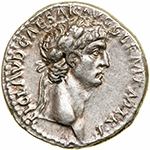 |
Claudius. Silver Denarius (3.76 g), AD 41-54. Rome, AD 41/2. TI CLAVD CAESAR AVG GERM P M TR P, laureate head of Claudius right. Reverse : EX S C / OB CIVES / SERVATOS in three lines within oak-wreath. RIC 16; BMC 18; RSC 35. Well struck and perfectly centered. Some luster still present, lightly toned. Extremely Fine.
Estimated Value $7,000 - 8,000.
View details and enlarged photos
| Realized
$8,813 |
Lot 3119 |
 |
Claudius. Silver Denarius (3.8 g), AD 41-54. Rome, AD 51/2. TI CLAVD CAESAR AVG P M TR P XI IMP P P COS V, laureate head of Claudius right. Reverse : PACI AVGVSTAE, Nemesis advancing right, pulling fold of her robe below neck, holding winged caduceus downwards with which she points at serpent before her. RIC 62; BMC 69; RSC 68. Perfectly centered on both sides with full legends. Extremely attractive with lovely iridescent toning. Extremely Fine.
The goddess Nemesis represented divine retribution and just fortune, and according to the poet Mesomedes was the daughter of Justitia. She was often invoked before a military campaign where it was customary to offer a sword in her honor. Her appearance on imperial coins is uncommon, mainly occurring under Claudius and Hadrian. She is normally but not always depicted winged, as here, and often pulls a fold of drapery from her neck so that she can spit into her bosom (Meleager Anthologia Graeca XII.229).
Estimated Value $7,000 - 8,000.
Ex C. K. Collection (Triton XIV, 3 January 2011), 648; Leu 86 (5 May 2003), 765.
View details and enlarged photos
| Realized
$8,813 |
Lot 3120 |
 |
Nero. Silver Denarius (3.6 g), as Caesar, AD 50-54. Rome, under Claudius, AD 51. NERONI CLAVDIO DRVSO GERM COS DESIGN, bare-headed and draped bust of Nero right. Reverse : EQUESTER / OR-DO / PRINCIPI / IVVENT in four lines on shield, behind which stands a spear. RIC 79; BMC 93; RSC 97. rARE. Well struck and perfectly centered with all letters complete. A couple of minute marks in the obverse field hardly worthy of mention. Lovely old cabinet toning with hints of iridescense present. Choice Extremely Fine.
Nero, born December 15 AD 37, was the son of Domitius Ahenobarbus and Agrippina the Younger. While Nero was still a small child his father died, and his mother later married her uncle, the emperor Claudius. Claudius already had a natural son, Britannicus, who was regarded as heir apparent, but after marrying Agrippina he began to favor Nero. In 51 Nero came of age, donning the toga virilis (the universal sign of Roman adulthood and citizenship), and received signal honors: consul deignate with tribunician powers, elevation to the high priesthoods, and the title princeps iuventutis which is commemorated by the reverse of this coin.
Estimated Value $6,000 - 7,000.
Ex Imagines Imperatorvm Sale (Aureo & Calicó, 8 February 2012), 29.
View details and enlarged photos
| Realized
$8,519 |
Lot 3121 |
 |
Nero, with Agrippina II. Silver Denarius (3.65 g), AD 54-68. Rome, AD 55. NERO CLAVD DIVI F CAES AVG GERM IMP TR P COS, jugate busts of Nero and Agrippina II right, Nero with a small fold of drapery behind neck, Agrippina draped. Reverse : AGRIPP AVG DIVI CLAVD NERONIS CAES MATER, the diefied emperors Augustus and Claudius seated on a cart drawn by four elephants left; in upper left field, EX S C. RIC 7; BMC 8; RSC 4. Well struck and perfectly centered with the portrait of Nero in high relief. Lovely old cabinet toning. An incredible coin! Superb Extremely Fine.
For the first few years of Nero's reign while he was still a minor, his mother Agrippina enjoyed unparalleled supremacy, firmly dominating the young emperor. Her portrait and title ostentatiously adorn the early coin issues from the reign, some with her bust alone and others, such as on this handsome denarius, showing jugate busts of her son and herself. As Nero became older he strongly resented Agrippina's dominance over him and meddling, and by AD 59 things had deteriorated to such a state of affairs that he had her murdered. In hindsight this is perhaps not entirely surprising; even by ancient standards the actions of the imperial family at this time were considered vile. Suetonius even records that on the day of Nero's birth, "Many people at once made many direful predictions from his horoscope, and a remark of his father Domitius was also regarded as an omen; for while receiving the congratulations of his friends, he said that 'nothing that was not abominable and a public bane could be born of Agrippina and himself.'" (Seut. Nero vi).
Estimated Value $20,000 - 25,000.
Ex NFA XXV (29 November 1990), 356.
View details and enlarged photos
| Realized
$23,500 |
Lot 3122 |
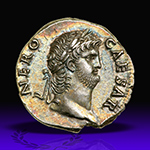 |
Nero. Silver Denarius (3.53 g), AD 54-68. Rome, ca. AD 64/5. NERO CAESAR, laureate head of Nero right sporting slight beard. Reverse : AVGVSTVS GERMANICVS, Nero standing facing, radiate and togate, holding Victory on globe and laurel branch. RIC 47; WCN 22; BMC 60; RSC 45. A wonderful bold strike on a full flan and perfectly centered. Every whisker on Nero is complete and the the facing figure of Nero on the reverse is also incredible. Lovely pastel iridescent toning on both sides adds to its appeal. Superb Extremely Fine.
Struck circa AD 64/5, this coin's reverse shows the monumental bronze statue of Nero in the guise of Sol that was originally just outside of the main palace entrance of Nero's Domus Aurea ('Golden House').
The Greek sculptor, Zenodoros, constructed the statue between AD 64 and 68, thus the representation on the coin predates the completed statue. After Nero's downfall, Vespasian replaced the head of the statue with one of the god Sol himself. In the second century, Hadrian had the statue moved adjacent to the Flavian Amphitheater, from which that building derives its popular name, the Colosseum.
Estimated Value $10,000 - 13,000.
View details and enlarged photos
| Realized
$44,650 |
Lot 3123 |
 |
Nero. Silver Denarius (3.47 g), AD 54-68. Rome, ca. AD 66/7. NERO CAESAR AVGVSTVS, laureate head of Nero right, sporting slight beard. Reverse : SALVS in exergue, Salus seated left, holding patera. RIC 60; WCN 60; BMC 90; RSC 314. Well struck and perfectly centered on both sides. Traces of luster present and lightly toned. Superb Extremely Fine.
Estimated Value $5,000 - 6,000.
View details and enlarged photos
| Realized
$8,225 |
|
|